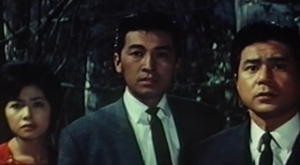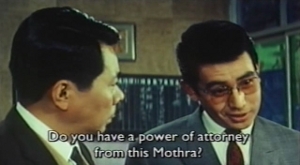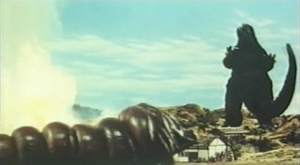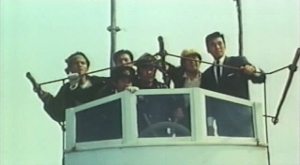
The international success of King Kong vs. Godzilla ensured it would be a major moment in the careers of its two top-billed stars and the director behind both of them, Ishirô Honda. Prior to directing the original Gojira ten years earlier, Honda specialized in slice-of-life dramas with the occasional break into that new, Hot Genre of the 1950s: the Workplace Comedy. No matter the story, these films were usually quiet pieces set on a slow boil, focused (like his much more famous monster movies) on small groups of ordinary people overcoming something or other through their unwavering hope for a better tomorrow.
These films were a refuge for Honda: small-scale, relatively everyday productions he could always escape to in between monster movies. Then he made the mistake of directing a workplace comedy/daikaiju eiga hybrid. After that, his professional goose was cooked. And thank God. Because, after three mediocre-to-shit sequels, Honda and the metric tons of talent he brought with him finally gave us a Godzilla film I can unconditionally rave about.
Well…maybe not “unconditionally.” But next to Godzilla Raids Again, this fourth entry in original (or Showa) series looks like Casa-fucking-blanca.

Mothra vs. Godzilla opens with a typhoon, washing away and/or flooding large sections of Japan’s coast. The next day, News Reporter Ichiro “Ichi” Sakai (Akira Takarada) and his young photographer, Junko “Yoka” Nakanishi (Yuriko Hoshi) are on hand, gravely assessing the devastation. Actually, that’s a lie: Ichi’s giving Yoka shit for being a perfectionist photographer, while a glad-handing local official gives him shit for daring to criticize the clean-up effort in print. The nerve of this guy; acting like some kind of journalist or something…
Everyone’s interrupted by the discovery of an enormous egg, washed ashore by the typhoon and already beset by the film’s Scientist, Professor Miura (Hiroshi Koizumi). Ichi, Yoka and the Professor are, in turn, brushed off by the mustachioed Kumayama (Yoshifumi “I was in Hidden Fortress, damnit!” Tajima), head of the pointedly-named Happy Enterprises. Kumayama announces he’s just bought the egg off of the local villagers. Understandably put out by the typhoon, they’re all too eager for Kumayama to get that thing off their beach. Kumayama’s already planning to make it the egg the centerpiece of a gigantic theme park/tourist attraction that has no relation to Disneyland whatsoever. No. none at all.
Our Reporter, Chick Photographer and Scientist retire to a nearby hotel, distressed by this news. Wouldn’t you know, it’s the same hotel Kumayama’s checked into and, as our three leads debate their Happy Enterprises problem, Kumayama meets up with his financial backer, Torahata (Kenji Sahara in a rare, Designated Villain role). Building a theme park around a giant monster’s egg may sound like a bad idea today, and that was just as true back then. But it sounded a lot less sillier in 1964, when Disneyland (“the happiest place on Earth”) was less than ten years old (younger, in fact, than Godzilla himself). Venture capitalists from Tokyo to Tuscon were falling all over themselves to hop on Uncle Walt’s bandwagon.

In Happy Enterprises, then, we see a critique of international Evil Capitalism that’s both sillier and more serious than Mr. Tako’s quest for a Pacific Pharmaceuticals monster mascot in the last film. And just like last time, some “backward” natives stand opposed to modernity’s relentless quest for Capital. This time, though, the natives are at least recognizable, particularly to fans of Mothra, like myself.
Yes, it’s the Shobijin (played once again by the fabulous Ito sisters, Yûmi and Emi, in some just-as-fabulous fur stoles), come to inform our Evil Capitalist of…things they never get the chance to talk about, since Torahata and Kumayama immediately attempt to capture the tiny twins. Fleeing, the psychic pair do what they should’ve done in the first place and hook up with Our Reporters and Professor. They explain the giant egg is, in fact, their god-monster Mothra’s, and could they, pretty-please, try to convince the Evil Capitalists to give it back nice and quiet like? Please, please, pretty-please?
Well, Our Heroes do their best, but what Capitalist (evil or otherwise) would take the word of two reporters and a biologist? Torahata gets his best line here, when he asks Our Heroes if Mothra’s given them power of attorney to go along with their foolish demands. Then Kumayama has to ruin things by laughing at this money-man’s bad joke and declaring it “a good one.” (Bastard. I hope you die first.) (Spoiler alert – he does – in the one of the bloodiest fights this genre’d seen to date.) Our Heroes unveil the Shobijin…and Kumayama wins me back by immediately offering Our Heroes one million yen for the twins. Each. Sure, he’s an international grab bag of Bad Guy cliches, but at least he’s consistent.

Dejected, the Shobijin depart on Air Mothra, leaving Our Reporters to tell their story to the masses and (hopefully) influence public opinion. It takes all of one scene for Ichi to grow dejected with that, since every column-inch he writes is one more inch of free publicity for Happy Enterprises and their upcoming theme park. They “don’t care what people think.” Gee, really? What a shock. They’ve already encased the egg inside a glass incubator and are eagerly promoting the rest of the park, despite it not being built yet. Not even the gruff words of Ichi’s editor (Jun Tazaki) can snap him out of his funk.
No, that duty falls to one of Ichi’s friends at this movie’s atomic research lab (could be the National Synthesis Nuclear Center, for all I know – Honda never gives us an establishing shot). He informs both Ichi and Yoka that crawling around that typhoon damage in the beginning left them both more than little radioactive. As is the weird, blue-green scale Yoka discovered in the surf. After going through decontamination, Our Heroes snatch Professor Miura up and set out to test the now-dry land for any potential public health disasters. Fifty-meter, fire breathing, black scaled, fin-backed disasters named Godzilla.
Yes, the King of Monsters is back…after being unceremoniously buried by the typhoon for half a movie. The military has a plan to stop him, of course…and it goes as well as you’d expect (poorly). This fuels Ichi and Yoka’s funk…until their Odious Comic Relief colleague, Jiro (Yû Fujiki – reprising his Odious Comic Relief role from the last movie, though he’s playing a different character) suggests they get Mothra to fight Godzilla for them. Honda might as well have comped little light bulbs into the space above everyone’s heads. He could’ve pulled it off. This movie already has some of the best bluescreen work in the series.

Through the magic of jump-cuts, Ichi, Yoka and the Professor make it to Infant Iwa Island. Their efforts to get the natives on their side go about as well as the JDSF’s efforts to kill Godzilla. Only the Peanuts aural intervention saves them from going home failures. Inside the Shobijin’s inner sanctum, the one still-verdant section of Iwa Island, Our Heroes discover Mothra’s Not Long For This World, and the entire island is, in fact, winding a deathwatch for their god. But because Godzilla’s presence threatens her egg as much as it threatens anything else any in his way, Mothra (through the Shobijin) agrees to fight for humanity with what little strength she has left.
This is a much more well-constructed story than its prequel, avoiding King Kong vs. Godzilla‘s problem of clashing tones. Like that film, it fuses two pre-existing monster movies into a hybrid creature, neither Godzilla nor Mothra, but both. For the second time in both Godzilla’s and Mothra’s overall cannon, the plot’s driven by an Evil Capitalist’s dastardly scheme to monetize atomic mutants. For the second time in two films, this dastardly scheme’s used to make broad social cometary, criticizing the relentless drive of some to mine the past for fast cash by portraying them as sneering, greedy, backstabbing gits.
Yet this time I don’t mind because, unlike it’s prequel, Mothra vs. Godzilla never artificially confines its two plot-lines for the sake of story convenience or budgetary restriction. Even if it does, I didn’t notice, which tells me Honda and returning screenwriter Shinichi Sekizawa did a good job covering their tracks. Thank God(zilla), because this could easily have turned into a disastrous retread of either King Kong vs. or Mothra, combining all the worst aspects of both. (As some films will in future.)

And if the main character triad of two Reporters and a Scientist didn’t clue you in, Sekizawa also wrote Mothra. The easy, clipped exchanges between Ichi and Yoka invoke younger versions of Michi and Sen the Snapping Turtle. I suspect Sekizawa wrote this as a direct sequel to Mothra and only changed everyone’s names once scheduling become a nightmare and recapturing Mothra‘s cast became impossible. Our main cast all act nice and chummy from the start, and there’s no need for Ichi and the Professor to bond over some annoying proto-Kenny, or his escaped pet. Making the two Evil Capitalists Japanese removes any overt, international, sociopolitcal underpinnings, or the need to give our Evil Capitalists back stories. (To say nothing of backstories that suggest they may, in fact, be Mutt Williams…but that’s just my pet theory about “Nelson’s” origins).
Instead, this feels like a remake of Mothra with Godzilla as a special guest star, removing all that moral ambiguity the Giant Bug God flew around with in her last movie, when she destroyed large swaths of two major cities on two continents in as many days. I won’t lie: the Mothra puppet they used here looks shopworn and frayed…but even that adds to the atmosphere of loss and death hanging over the movie’s back half, because Mothra’s about to kick the bucket, one way or another.. And like the country she defends, she must fight the living embodiment of Modernity and its Horrors (Godzilla) in order to ensure her legacy (that egg).
No wonder this movie does all it can to make Mothra look bad ass. This can easily be seen as “silly,” since Godzilla’s trashed cities, walked through electric fences, and melted whole battalions of tanks…just in this movie. How can a fucking moth stand against something that went toe-to-toe with King Kong? By being twice her original size, for one thing. And through a whole lot of shot/reaction-shot fighting. We see Mothra flapping her wings. Cut to: Godzilla, reacting, staggered by the wind. We see Godzilla let out an atomic blast. Cut to: Mothra, reacting, getting blasted in the face. Shots of the two interacting (as in the famous tail-drag) are all-too brief….and, considering what we have, that’s probably for the best.

In the end, though, I don’t care, because this fight has a dramatic structure – an internal architecture as well-crafted as the film it wraps up. Special effects director Eiji Tsuburaya took everything the last film taught him and improved upon it. This Godzilla suit is slimmer and more expressive than its predecessors, allowing Haruo Nakajima to give one of my favorite Godzilla performances of the entire series. The film even incorporates its titular star’s lingering awkwardness into the narrative by having Godzilla actually interact with his environment, slipping on streets that crumble under his weight, or snagging his tail on radio towers…which he immediately turns on and dismantles, treating everything like an instinctual enemy.
Out of all the ways Godzilla’s been portrayed over the years, this is my favorite: the Monster As Foe of Man. But that’s only half the story. Mothra vs. Godzilla also has one of my favorite daikaiju casts. Thanks to an overabundance of Honda Repertoire Company veterans, this movie’s cast sheet reads like a game of Six Degrees. Akira Takarada played Ogata, first among Working Class Heroes, in the original Godzilla. He and Yuriko Hoshi have such easy chemistry, in part, because they’d previously co-starred in 1961’s The Last War…which featured special effects by (drum roll please) Eiji Tsuburaya (of course). Hiroshi Koizumi was the Scientist in Mothra and the Working Class Hero of Godzilla Raids Again. And Kenji Sahara…poor, scenery-chewing Kenji Sahara’s had some part in every Toho monster movie up to this point. He must’ve been like a human good luck charm back in this, Toho’s and Honda’s golden age. His presence alone is enough to infest the flat, oily, stock villain he’s playing with a modicum of suave class.

It’s good to see the cast of a daikaiju film holding their movie together, instead of doing their usual thing and stopping it dead in its tracks. They earn a lot of my good will by – in an extraordinary move for human daikaiju movie protagonists – joining in the evacuation effort, only stopping to watch monsters fight from Minimum Safe Distance after they’ve rescued a literal boat-load full of civilians. Who, in another twist other monster movies should rip-off more often, are not all magically evacuated out of Godzilla’s path.
See this movie for its cast (and their swinging, mid-60s fashions), if nothing else. All of them are excellent, mid-century actors, guided by a crew of authentic genre masters. Own it for its historical importance and for the incredible amounts of fun involved. This is the film King Kong vs. Godzilla wanted to be, the Godzilla film other Godzilla films would strive to emulate for decades afterward. Because Mothra vs. Godzilla is, in fact, that good. If not for the next two films, this would be the aesthetic high point of Godzilla’s original series. Thankfully, this begins an epic, daikaiju movie trilogy that still stands as a fan favorite to this day.
![]()
![]()
![]()
![]()


Hey, GIVE US BACK OUR EGG!!!!
The egg is the property of Happy Enterprises…a subsidiary of the Umbrella Corporation…